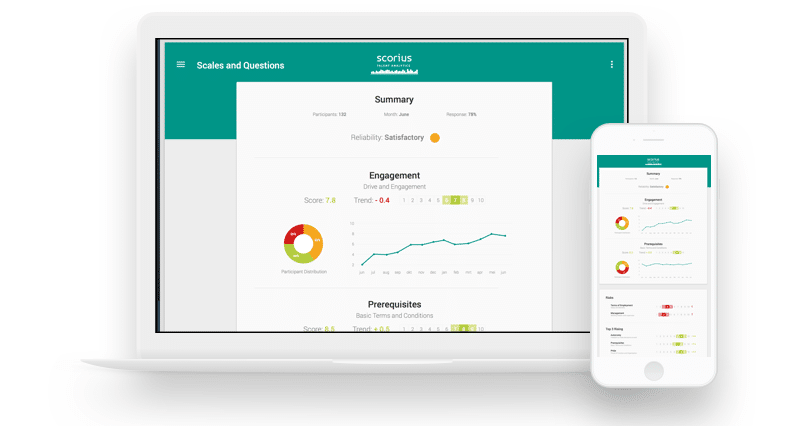Factsheet talent analytics: what is the added value for HR?

In HR there is a lot going on around HR analytics, talent analytics and data driven HR. All the experts tell you that driven HR is the way forward. In reality a lot of HR professionals are uncertain about where to begin. Before you start there is a different question that needs to be addressed. Why would you invest in data driven HR? What’s in it for me? How does my organization benefit?
The last few years there has been more and more research showing that data driven HR leads to a better performing organization. We made a list of relevant research arranged by topic.
Before we start: what is talent analytics?
Data driven HR, talent analytics, HR analytics, these are all terms for the same way of working. New technologies generate more and more data in every HR department. This data can be analyzed to make better decisions about people. Talent analytics is about analyzing data for the purpose of answering talent management questions. Data from assessments, employee surveys and performance rating can be compared to other business data like client satisfaction or financial data. This way you can discover the causes of unwanted employee turnover, calculate the ROI of training courses, optimize the recruitment process etc. The aim is to help the organization attract, develop and retain the best talent in an optimal way.
Research on data driven HR
Research by the Boston Consulting Group from 2014 shows that organizations that are more advanced in the HR analytics field also perform better financially. Furthermore the research shows that HR professionals that work with data have more impact on business strategy. (1)
HR professionals with ambition that are looking for impact beyond the borders of HR can use a data driven HR approach to do so.
Research by Deloitte shows that organizations that work with predictive talent analytics create 30% more stockholder value. (2) Taken together these two studies show that talent analytics lead to better financial performance.
Analytics and recruitment
For most organizations the workforce is the biggest expense. In many organizations the costs of salaries is 70% of the total budget. People that get hired and turn out to be a bad fit with their new function is still a common problem. These are costly mistakes. Not many organizations are fully aware of the impact of recruitment on financial performance.
Research by IBM shows dat 39% of employees would not be hired again(3). This means that over 30% of hiring decisions are more or less recruitment mistakes.
Why is it so important to hire the right people? Research by Harvard business review shows that a top salesman sells 6 times more than average. A top software developer is even 9 times more effective than average. On average top performers are 4 times more effective than average performers.(4) Wat would happen if you only had top performers in your organization? What would be the financial impact if the performance of employees would improve 4 times? That question is exactly the reason that Google invests so many resources in optimizing it’s recruitment efforts and only hires the top 0,25% of all applicants (5) Everyone at Google has a part in hiring decisions, the decision is never made by a single person and there are at least 4 interviews before the decision is made. Read more about recruitment at Google in the excellent book by Laszlo Bock. (5)
The research by IBM also shows that when the focus in recruitment is on efficiency and speed this leads to more hiring mistakes. When there is a focus on quality of hire the number of hiring mistakes goes down. Analyzing recruitment data is an effective way of finding out which characteristics and behavior lead to better performance in a specific role. A data driven recruitment process leads to less hiring mistakes and higher performance. Even when the number of mistakes is reduced by 5% this will lead to a cost of saving of tens of thousands of euro’s.
Engagement
Research by Gallup shows that organizations with more than average employee engagement are 20% more productive, create 22% more margin, have 10% higher client satisfaction, 37% less absenteeism and up to 65% less unwanted employee turnover. (6) Research by CEB shows that 70% of the total workforce is not happy in their current job. (7) The impact of employee engagement is huge and there is a lot of room for improvement. Still there are only few organizations that are actively investing in creating an optimal work environment. Google is also a bright example in this field. Google measures constantly how employees experience their work. Bad management is a strong factor for disengagement. Employees at Google rate their manager every month on a handfull of important behaviours. If a managers score is below 7, HR will come to help.
The last few years there has not been much of a war on talent due to the global economic crisis. This might be changing in the coming years. Research by CEB shows that 66% of organizations will suffer under a lack of talent in the next 3 to 5 years, 70% of employees are not satisfied with job opportunities at their current employer. 70% of investments in learning and development do not lead to better performance. High potential employees add 91% more value to the organization than average.(7) These number show the importance of building an effective talent management strategy.
Conclusion
Many organizations say their employees are their most important asset. In the real world many organizations do not act accordingly. Many employees are disengaged in jobs that do not fit their qualities. While motivated employees with the right qualities have a huge impact on the financial results of the organization. Data driven HR is an valuable opportunity to add more value as an HR department and have impact on the performance of the organization.
1) Creating People advantage 2014-2015: How to set up great HR functions. Boston Consulting Group. (2015)
2)Josh Bersin, Karen O’Leonard, and Wendy Wang-Audia, High-impact talent analytics: Building a world-class HR measurement and analytics function, Bersin by Deloitte. (2013)
3) ‘The secret to reducing hiring mistakes? It’s in the metrics’ R. Rasch. IBM smarter workforce institute. (2015)
4) Making star teams out of star players’, M.C. Mankins, A. Bird, J. Root. Harvard business review. (2013)
5) ‘Work rules. Insights from inside Google that will transform how you live and lead’ L. Bock. John Murray (Publishers). (2015)
6) ‘How employee engagement drives growth’ S. Sorenson. Gallups state of the workplace report 2013. (2013)
7) ‘Top Insights 2015-2016 edition. Bring a respected voice to the executive table’. CEB. (2016)



